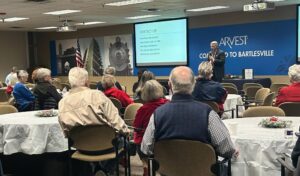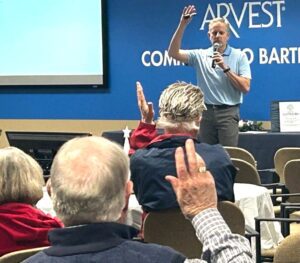
Upwards of 40 Bartlesville residents turned out last Thursday evening for a Ward 1 Town Hall meeting, hosted by Mayor Dale Copeland.
Copeland and City staff presented a State of the City report and answered questions by those in attendance.
The main topic of the evening was water supply. Drought conditions persist in Southeast Kansas, where the watershed areas for Hulah and Copan lakes are located. This has resulted in declining lake levels at both lakes, which are the City’s primary water supply sources.
During the meeting, Water Utilities Director Terry Lauritsen outlined steps the City has taken since the drought of 2001, when Hulah Lake was less than 20 percent full.
“In 2001, we experienced two months of a moderate drought and our water supply declined to less than 20 percent,” Lauritsen said. “With this drought, we’ve experienced 18 months — and still counting — of exceptional and extreme drought conditions, and the lowest our water supply has dipped is 56 percent. This is because of the steps we’ve taken since the 2001 drought.”
Those steps include:
Managing Water Resources, prior to the 2001-2002 drought, the City used water from Hulah Lake and Hudson Lake first, and supplemented with water from the Caney River during emergencies. Since 2013, the City has used water from the Caney River first, and supplements with water from Hulah and Hudson lakes.


“The Caney River pump station runs year ’round and provides all of the City’s water needs — except during portions of summer, which is supplemented by water from Hulah and Hudson,” Lauritsen said. “This change in water resource management preserves water in these lakes.”
Changing the water rate structure so that higher-volume users pay more, and increasing rates overall to pay for the construction of a new water treatment plant in 2006. These increases in water rates resulted in less water being used by customers, Lauritsen said.
Acquiring an additional 1 mgd from Copan Lake, which took 12 years and required intervention by the U.S. Congress to make the cost economically feasible.
Implementation of the Water Shortage Ordinance, which placed limits on outdoor water use and included increased emergency water rates when water supply reaches certain thresholds.
“The ordinance provides a mechanism to be proactive in managing water use to ensure that sufficient water is available throughout a drought,” Lauritsen said.
Other topics discussed at the forum were:
- The drought and history of water in Bartlesville
- Proposed changes to the City Charter
- Capital projects
- Project funding
- The budget process, revenue & finances
You might also like:
